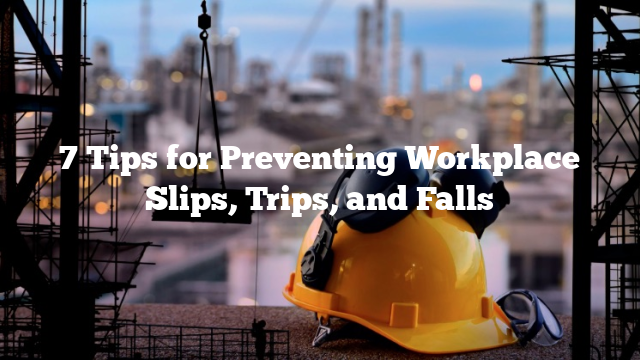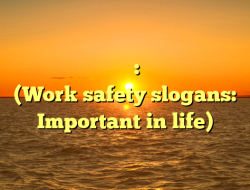Workplace Slips Trips and Falls Prevention
As an employee or an employer, have you ever thought about the importance of preventing slips, trips, and falls in the workplace? Workplace slips, trips, and falls are among the leading causes of injuries and fatalities in the workplace. According to the National Safety Council, in 2019, 240,160 injuries occurred in the workplace due to slips, trips, and falls, resulting in 880 deaths. These statistics are alarming and emphasize the importance of preventing workplace slips, trips, and falls.
What are the main causes of workplace slips, trips, and falls?
Slips are usually caused by wet or oily surfaces, while trips are usually caused by uneven surfaces, clutter, or poorly maintained floors. Falls, on the other hand, are caused by a combination of factors, including slipping or tripping, working at heights, and using unstable equipment or ladders. Injuries from these accidents can be severe and can range from minor bruises and scrapes to serious head injuries, broken bones, and even death.
Tutorial of Workplace Slips Trips and Falls Prevention
Here are some simple steps you can take to prevent slips, trips, and falls in the workplace:
1. Keep floors clean and dry. Use warning signs to indicate wet or slippery floors.
2. Eliminate clutter and obstacles. Keep walkways, stairs, and aisles clear of any objects or materials that may cause slipping, tripping, or falling.
3. Maintain good lighting. Ensure that the workspace is well-lit to prevent accidents.
4. Provide appropriate footwear. Encourage employees to wear shoes with slip-resistant soles to reduce the risk of slips and falls.
5. Train employees. Provide training on how to identify and avoid hazards, and how to report any hazards or unsafe conditions.
Tips of Workplace Slips Trips and Falls Prevention
Here are some additional tips to help prevent workplace slips, trips, and falls:
1. Use slip-resistant mats in areas where spills or wet floors are common.
2. Keep ladders and other equipment in good condition and ensure that they are used properly.
3. Install handrails on stairways and walkways to provide additional support.
4. Conduct regular safety inspections to identify and correct hazards.
5. Encourage employees to report any safety hazards or concerns to their supervisor.
Facts about Workplace Slips Trips and Falls Prevention
– Slips, trips, and falls are responsible for 15% of all accidental deaths and are the second leading cause of accidental deaths behind motor vehicle accidents.
– The average workers’ compensation claim for a slip, trip, or fall injury is $20,000.
– Falls from heights are the leading cause of fatalities in the construction industry.
– Slip and fall injuries are more common in certain industries, including healthcare, retail, and food service.
Listicle of Workplace Slips Trips and Falls Prevention
Here are five common hazards that can cause workplace slips, trips, and falls:
1. Wet or slippery floors
2. Uneven or damaged flooring
3. Clutter and obstacles
4. Poor lighting
5. Working at heights
Important note: “It is essential to identify and eliminate these hazards to prevent workplace accidents.”
Question and Answer of Workplace Slips Trips and Falls Prevention
Q1. What are the common injuries resulting from workplace slips, trips, and falls?
A1. Workplace slips, trips, and falls can result in minor injuries such as bruises and scrapes, but they can also cause more severe injuries such as broken bones, head injuries, and even death.
Q2. How can employers prevent workplace slips, trips, and falls?
A2. Employers can prevent workplace slips, trips, and falls by implementing safety policies, providing employee training, and conducting regular safety inspections to identify and correct hazards.
Q3. Are slip-resistant shoes necessary to prevent slips and falls in the workplace?
A3. Slip-resistant shoes can help reduce the risk of slips and falls in the workplace, but they are not the only solution. Employers should also focus on keeping floors clean and dry, eliminating clutter, and providing adequate lighting.
Q4. What industries are most at risk for workplace slips, trips, and falls?
A4. Certain industries, including healthcare, retail, and food service, are more likely to experience slips, trips, and falls due to the nature of the work involved.
Conclusion of Workplace Slips Trips and Falls Prevention
Preventing workplace slips, trips, and falls should be a top priority for employers and employees alike. By identifying and eliminating hazards, providing employee training, and conducting regular safety inspections, we can create a safer workplace for everyone. Remember, a safe workplace is a productive workplace!
Recommendations:
- Workplace Safety Signs And Symbols, Why so important? Proper workplace safety signs and symbols always place in a construction site, mining site, oil and gas site or hospital and your workplace.
- Health & Safety Pictures If you're searching for health & safety pictures pictures information connected with to the health & safety pictures topic, you have pay a visit to the ideal site. Our site…
- Child Safety Week 2019 Logo Safe sound week is a nationwide event to celebrate the successes of businesses that have implemented safety and health programs in the workplace. Throughout the year businesses show their commitment…
- 7 Essential Tips for Preventing Workplace Slips, Trips, and… Workplace Slips Trips and Falls Prevention Did you know that slips, trips, and falls are one of the leading causes of workplace accidents? According to the US Bureau of Labor…
- Workplace Safety Poster Singapore 27121 likes 128 talking about this 562 were here. See more ideas about health and safety health and safety poster and safety in the workplace. Workplace Safety Posters Downloadable And…
- The Importance of Workplace Slips, Trips, and Falls… Workplace Slips, Trips, and Falls Prevention: Keeping Your Employees Safe As an employer, one of your top priorities should be ensuring the safety of your employees. Unfortunately, slips, trips, and…
- How to Prevent Workplace Slips, Trips, and Falls: A… Workplace Slips, Trips, and Falls Prevention: How to Keep Your Employees Safe Slips, trips, and falls are some of the most common accidents that happen in workplaces. According to the…
- Health And Safety Law Poster A3 Free Download The reason that these posters are free is that this still accounts for a vast majority of workplace injuries. New hse law poster from 2014 download free leaflets and pocket…
- Occupational Health And Safety Logo Information and documents a z. Occupational health and safety png images. Occupational Health Safety Logo Free Transparent Png Download Health and safety sign board hair. Occupational health and safety logo.…
- Safe And Healthy Images If you're looking for safe and healthy images images information connected with to the safe and healthy images keyword, you have visit the right blog. Our site frequently provides you…
- Health And Safety Topics Occupational health safety is the industry leading news magazine enewsletter and website for occupational health and safety professionals focusing on problem solving solutions latest news. Health safety committee member health…
- Health And Safety Inspection Report Template Use for office health and safety audits. Add a badge to your website or intranet so your workers can quickly find answers to their health and safety questions. Safety Report…
- 10 Tips for Preventing Slips, Trips and Falls in the… Workplace Slips Trips and Falls Prevention: Essential Tips and Facts Accidents in the workplace can happen anytime, anywhere. One of the most common types of these accidents is slips, trips,…
- Safety Poster While we are talking about safety poster, most of us need to be a lot more familiar with the safety element of our lives.
- Work Health And Safety Images If you're looking for work health and safety images images information linked to the work health and safety images topic, you have visit the right site. Our site frequently provides…
- National Safety Poster The national safety day theme 2019 was cultivate and sustain a safety culture for building nation. National seminar on road safety 15 16 october 2019 new delhi nsc invites article…
- Safety Committee Images If you're searching for safety committee images images information linked to the safety committee images topic, you have visit the right site. Our site frequently provides you with suggestions for…
- Sample Of Safety Inspection Checklist There are several ways to perform safety inspections of a workplace task or job. Safety inspection checklist buildingdepartments. 18 Inspection Checklist Examples Samples Pdf Word Pages The best checklist for…
- Safety Quotes Workplace Display them around your workplace or add them to internal newsletters. The use of silly and meaningless safety slogans matters it creates a distraction and delusion that safety and risk…
- Workplace Health And Safety Logo The orange color also is representative of the cautious and careful attitude necessary to. Find health and safety logo stock images in hd and millions of other royalty free stock…
- Free Workplace Health And Safety Posters See more ideas about office safety safety posters and workplace safety. Download public administration and safety industry poster a4 portrait as a pdf 653 mb download public administration and safety…
- The Importance of Workplace Slips, Trips, and Falls… Introduction: Workplace slips trips and falls prevention is a crucial topic to consider for every company and organization. According to the National Safety Council, slips, trips, and falls are the…
- Health And Safety Background Images If you're looking for health and safety background images images information connected with to the health and safety background images topic, you have pay a visit to the ideal blog.…
- 5 Essential Tips for Preventing Slips, Trips and Falls in… Introduction: Did you know that slips, trips, and falls are the leading cause of workplace accidents? In fact, according to the National Safety Council, over 9 million slip, trip, and…
- National Safety Month Logo 2019 In australia october is national safe work month a time to make your commitment to improving safety and health in your workplace. This time each year we get 10s of…
- Occupational Safety Logo Looking for free vectors of health and safety. The institution of occupational safety and health iosh is a british organisation for health and safety professionals. Occupational Safety And Health Logo…
- Safety Quotes For The Workplace Display them around your workplace or add them to internal newsletters. Apr 25 2019 explore sotorioss board safety quotes for workplace on pinterest. Safety Quotes For The Workplace Safety In…
- Health And Safety Funny Images If you're searching for health and safety funny images images information related to the health and safety funny images interest, you have pay a visit to the right site. Our…
- Inspirational Safety Quotes For Workplace Relevant quotes are a great way to communicate key safety concepts. The use of silly and meaningless safety language matters it creates a distraction and delusion that safety and risk…
- 10 Tips for Preventing Workplace Slips, Trips, and Falls Introduction: Slips, trips, and falls are the most common cause of workplace injuries, leading to a significant number of fatalities and injuries each year. These accidents can happen in any…
Advertisement
Scroll to Continue With Content




